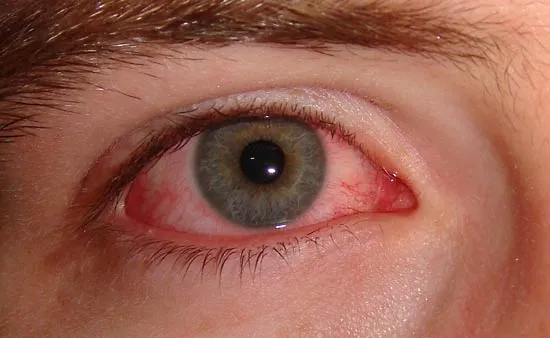Allergies, bacteria, viruses, or bacterial conjunctivitis are possible causes. Both bacterial and viral conjunctivitis are easily contagious.
Causes and risk elements
Conjunctivitis comes in three primary varieties: allergic, infectious, and chemical. Depending on the type, conjunctivitis has a variety of causes.
An allergic eye condition
People with seasonal allergies are more likely to develop allergic conjunctivitis. When they come into contact with something that causes an allergic reaction in their eyes, they develop it.
A persistent foreign body in the eye can lead to a kind of allergic conjunctivitis called giant papillary conjunctivitis. This type of conjunctivitis is more common in people who wear stiff or hard contact lenses, soft contact lenses that are not changed frequently, have an exposed suture on the surface of their eyes, have prosthetic eyes, or any of these conditions.
Infectious conjunctivitis
- Bacterial conjunctivitis is an infection most often caused by staphylococcal or streptococcal bacteria from your own skin or respiratory system. Insects, physical contact with other people, poor hygiene (touching the eye with unclean hands), or using contaminated eye makeup and facial lotions can also cause the infection. Sharing makeup and wearing contact lenses that are not your own or are improperly cleaned can also cause bacterial conjunctivitis.
- Viral conjunctivitis is most commonly caused by contagious viruses associated with the common cold. It can develop through exposure to the coughing or sneezing of someone with an upper respiratory tract infection. Viral conjunctivitis can also occur as the virus spreads along the body’s own mucous membranes, which connect the lungs, throat, nose, tear ducts and conjunctiva. Since the tears drain into the nasal passageway, forceful nose blowing can cause a virus to move from your respiratory system to your eyes.
- Ophthalmia neonatorum is a severe form of bacterial conjunctivitis that occurs in newborn babies. This is a serious condition that could lead to permanent eye damage if it is not treated immediately. Ophthalmia neonatorum occurs when an infant is exposed to chlamydia or gonorrhea while passing through the birth canal. For several years, U.S. delivery rooms have applied antibiotic ointment to babies’ eyes as a standard prophylactic treatment.
Conjunctivitis due to chemicals
Chemical conjunctivitis can be brought on by irritants such air pollution, pool chlorine, and chemical exposure.
Symptoms
Symptoms vary with the causes discussed above. Allergic symptoms include clear, watery discharge along with mild redness. Itching, sometimes severe, may or may not occur. With bacterial infections, there is typically minimal pain but a possibly dramatic appearance with moderate redness and almost always a yellow/green discharge, sometimes extreme. This discharge can also make the eyelids red and swollen and can attach itself to the eyelashes for a crusty appearance.
Bacterial infections can be more severe in patients that wear contact lenses. There is also a risk of a bacterial corneal ulcer developing in contact lens wearers which would include severe pain and light sensitivity. Viral infections can also cause moderate redness and are usually painful. The pain is typically a sandy, gritty feel like something may be in the eye. There can also be a moderate to severe light sensitivity.
Diagnosis
A thorough eye exam can be used to identify conjunctivitis. The following tests, which focus particularly on the conjunctiva and the tissues around it:
- The patient’s medical history will help identify the symptoms, when they first appeared, and whether any underlying environmental or general health issues are making the situation worse.
- Visual acuity measurements to determine whether vision has been affected.
- Evaluation of the conjunctiva and external eye tissue using bright light and magnification.
- Evaluation of the inner structures of the eye to ensure that no other tissues are affected by the condition.
- Conjunctival tissue smears or cultures may be used in additional testing. When conjunctivitis is chronic or when treatment is not working, this is very crucial.
Treatment
- Comfort the patient more.
- Shorten the duration of the infection or inflammation.
- Halt the spread of the infection in conjunctivitis that is infectious.
- The etiology of conjunctivitis determines the best course of treatment.
Allergic conjunctivitis
The first step is to remove or avoid the irritant, if possible. Cool compresses and artificial tears sometimes relieve discomfort in mild cases. In more severe cases, nonsteroidal anti-inflammatory medications and antihistamines may be prescribed. People with persistent allergic conjunctivitis may also require topical steroid eye drops. Oral antihistamines may also be prescribed.
Infectious conjunctivitis
This type of conjunctivitis is usually treated with antibiotic eye drops or ointments. Bacterial conjunctivitis may improve after three or four days of treatment, but patients need to take the entire course of antibiotics to prevent a recurrence. Viral conjunctivitis. No drops or ointments can treat viral conjunctivitis. Antibiotics will not cure a viral infection. Like a common cold, the virus has to run its course, which may take up to two or three weeks. Symptoms can often be relieved with cool compresses and artificial tear solutions. For the worst cases, topical steroid drops may be prescribed to reduce the discomfort from inflammation. However, these drops will not shorten the infection. The viral infection Epidemic Keratoconjunctivitis (EKC) is very contagious and is the red-eye most associated with the term “pink eye”.
Prevention
There is no one preventive measure because there are so many reasons. Early detection and intervention can help stop the illness from getting worse. It also helps to stay away from allergy triggers as much as possible. Even when there are no issues, frequent hand washing and keeping hands away from the eyes can still make a difference.
































